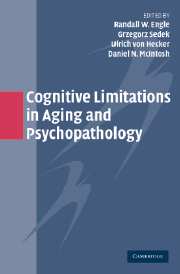Book contents
- Frontmatter
- Contents
- List of Contributors
- Preface
- Acknowledgments
- 1 Cognitive Limitations in Aging and Psychopathology: An Introduction and a Brief Tutorial to Research Methods
- SECTION I WORKING MEMORY AND COGNITIVE FUNCTIONS
- 2 Working Memory Capacity in Hot and Cold Cognition
- 3 Age Differences and Individual Differences in Cognitive Functions
- 4 Stress and Working Memory: Between-Person and Within-Person Relationships
- SECTION II AGING AND PSYCHOPATHOLOGY OF COGNITIVE CONTROL
- SECTION III ATTENTION, INHIBITION, AND REASONING PROCESSES
- Name Index
- Subject Index
- References
3 - Age Differences and Individual Differences in Cognitive Functions
Published online by Cambridge University Press: 20 May 2010
- Frontmatter
- Contents
- List of Contributors
- Preface
- Acknowledgments
- 1 Cognitive Limitations in Aging and Psychopathology: An Introduction and a Brief Tutorial to Research Methods
- SECTION I WORKING MEMORY AND COGNITIVE FUNCTIONS
- 2 Working Memory Capacity in Hot and Cold Cognition
- 3 Age Differences and Individual Differences in Cognitive Functions
- 4 Stress and Working Memory: Between-Person and Within-Person Relationships
- SECTION II AGING AND PSYCHOPATHOLOGY OF COGNITIVE CONTROL
- SECTION III ATTENTION, INHIBITION, AND REASONING PROCESSES
- Name Index
- Subject Index
- References
Summary
Here is a pair of very simplistic hypotheses: (1) Differences among groups or individuals in cognitive performance can all be reduced to a single source, for instance, general intelligence. (2) This source is the same for all comparisons among groups of individuals that differ in broad cognitive functioning (e.g., children vs. adults, younger vs. older adults, healthy vs. cognitively impaired populations) such that the pattern of differences across various indicators of cognitive performance will be the same for every such group contrast.
In their plain form, these statements are certainly wrong. In a moderated version, however, they both have considerable merit. Cross-sectional comparisons of young adults (around 20 years of age) and older adults (age 60 and above), for instance, show that older age is associated with reduced cognitive performance across a wide variety of tasks, and a large portion of the age variance can be accounted for by a single factor in structural equation models (Salthouse, 1996; Lindenberger, Mayr, & Kliegl, 1993). Likewise, individual differences in cognitive abilities can to a large degree be captured by the g factor of intelligence (Jensen, 1998), which in turn is strongly associated with working memory capacity (Engle, Tuholski, Laughlin, & Conway, 1999; Kyllonen, 1996; Süß, Oberauer, Wittmann, Wilhelm, & Schulze, 2002). Research on the aging of cognition has also shown that the pattern of age differences across a broad set of speeded tasks can often be described by a simple linear function: older adults' latencies equal younger adults' latencies on the same tasks or conditions, multiplied by a constant slowing factor (Cerella, 1985) or incremented by a constant (Verhaeghen & Cerella, 2002).
- Type
- Chapter
- Information
- Cognitive Limitations in Aging and Psychopathology , pp. 44 - 72Publisher: Cambridge University PressPrint publication year: 2005
References
- 5
- Cited by

